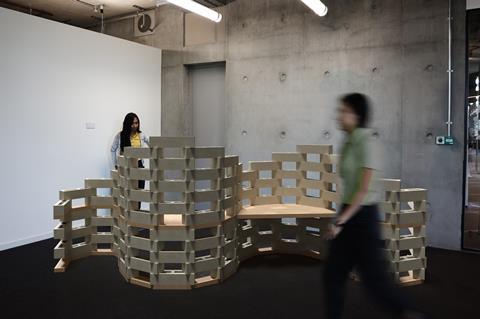A collaboration between Seratech, AKTII and Byrne Brothers sees a unique approach to carbon-neutral concrete

Seratech, AKTII and Byrne Brothers team up on an architectural installation for the London Design Festival 2022, showcasing an approach to carbon-neutral concrete.
A spin-out enterprise from Imperial College London, Seratech has developed a chemical process to sequester CO2 in mineral form. According to the team, the process creates waste-free construction materials that will allow carbon to be stored in the buildings and infrastructure of our cities.
The installation demonstrates the first samples of Seratech’s concrete in use. The exhibit is made from a series of uniform blocks that pivot around a template of re-used formwork, which serves as an integrated seat.
The blocks are locked into place using hemp rope, making the structure demountable. It can be reconfigured into other forms and expanded as more blocks become available and will be reused in a number of locations over the next year.
Each of the blocks represents a step in the development of the technology, documenting the evolution from traditional Portland cement through to the carbon-neutral concrete containing Seratech’s cement replacement material.
According to the team, the process creates waste-free construction materials that will allow carbon to be stored in the buildings and infrastructure of our cities
According to manufacturers, the curved form of the structure provides its strength, meaning only a single skin of blocks is needed. This strength allows the wall to be highly perforated, further reducing the material required and achieving more with less.
The process developed by Seratech uses olivine, a magnesium silicate rock, as the basis of a series of chemical processes that capture CO2 from the flue of a cement kiln, or any other industrial source. This process produces two materials, each with uses in construction.
The first material is silica, which can be used as a cement replacement material. When the proportions are right the resulting cement can be carbon neutral while also claiming to offer early strength gain and high final strength.
The second material is magnesium carbonate from which a range of sustainable construction materials can be manufactured, including alternatives to carbon-intensive clay-fired bricks.
Research is ongoing to optimise the efficiency of the process, with plans to design and build a pilot plant in collaboration with the industry to create zero-carbon products over the next two years.
















No comments yet